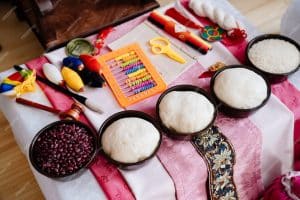Korean Age Milestones: From Doljanchi To Baegil
In Korean culture, age is not just a number; it is a fundamental aspect of identity, social interactions, and milestones in life. Certain age milestones hold deep cultural meaning and are often celebrated with special ceremonies, rituals, and family gatherings. While modern Korea follows the international age system (where age is calculated based on the actual date of birth), traditional Korean age milestones, based on the older East Asian method, still play an important role in cultural practices and celebrations. This article explores some of the most significant age milestones in Korea and their cultural significance. You can learn Korean online by knowing what the special age terms are called.
- Doljanchi (First Birthday)
One of the most important age milestones in Korea is the Doljanchi (돌잔치), which celebrates a child’s first birthday. This celebration is rooted in ancient traditions, where infant mortality rates were high, and surviving the first year was seen as a blessing. The first birthday party is often a grand affair, with family, friends, and relatives gathering to celebrate the child’s survival and growth.
- The Ritual: A key part of the Doljanchi is the “doljabi” ceremony, in which the child is presented with a variety of objects (such as a pencil, string, money, or rice) placed before them. The object the child chooses is believed to foretell their future career or path in life. For example, picking the pencil might signify a scholarly future, while choosing the money could symbolize wealth and prosperity.
- The Attire: On this special day, the child often wears a traditional hanbok, a colorful and elaborately designed outfit, symbolizing the child’s connection to Korean culture and heritage.
The Doljanchi is a joyful occasion filled with prayers for the child’s health, longevity, and success.
- Gabae (60th Birthday)
The Gabae (환갑) celebration marks the 60th birthday and is considered a significant milestone in Korean culture. Historically, reaching the age of 60 was seen as an impressive accomplishment due to shorter life expectancies. The Gabae celebration is a time to honor the individual’s life and achievements, as well as to show gratitude for their contributions to family and society.
- The Symbolism: The 60th birthday is important because, in the traditional Korean sexagenary cycle (which is based on a combination of the 10 heavenly stems and 12 earthly branches), a person completes a full cycle after 60 years. This milestone is seen as a rebirth, symbolizing the start of a new life stage, often marked by family celebrations, feasts, and ceremonies.
- The Celebration: During the Gabae, the birthday person is typically given a special hanbok and presented with gifts and blessings. Family members often gather for a large meal, and prayers for longevity and health are offered. The event can be formal and ceremonial or more casual, depending on the family’s preferences.
- Cheonguk (70th Birthday)
The Cheonguk (칠순) marks the 70th birthday in Korea and is another important milestone in the culture. Celebrating a person’s 70th birthday honors the wisdom and experience they have accumulated over the years. This milestone is particularly significant as life expectancy has increased, and reaching 70 is often seen as a remarkable achievement.
- Celebration: The Cheonguk celebration is typically a family-centered event with a more intimate atmosphere compared to the Gabae. Family members and close friends gather to offer congratulations and blessings. Gifts are often given, and the celebrant may receive a red vest or clothing to signify protection and vitality.
- Cultural Significance: The 70th birthday is considered a time to reflect on the past, give thanks for the blessings of life, and look forward to the future. In some cases, individuals may also celebrate with prayers for continued good health.
- Baegil (100th Birthday)
The Baegil (백일) marks the 100th birthday, which is a rare and highly celebrated occasion in Korean culture. Reaching 100 years of age is considered a major achievement, reflecting not only personal longevity but also the deep respect and reverence for the elderly in Korean society.
- Ceremonial Celebration: The Baegil celebration is often a grand event with extended family, friends, and sometimes even community members attending to celebrate the milestone. It is a time for family members to express their respect for the individual and their deep gratitude for their life and teachings.
- Gift-Giving and Prayers: During the Baegil, the individual may receive gifts, and special prayers may be offered for further health and longevity. The event is often accompanied by a festive meal, and it is customary for the celebrant to be dressed in a traditional hanbok.
In modern times, some individuals celebrate their 100th birthday with the entire family gathering to honor not just the individual but also the values of respect for elders and family unity.
- The Celebration of Longevity: 88th and 99th Birthdays
In addition to these major milestones, certain ages such as 88 and 99 are also celebrated in Korea with respect and joy.
- 88th Birthday (Palgim): The 88th birthday is considered an important milestone due to the number 88 being associated with prosperity and happiness. Families often celebrate with close gatherings, offering prayers and well-wishes for good health in the years to come.
- 99th Birthday (Hansu or Hanjoo): The 99th birthday is another revered occasion, as it symbolizes near completion of a century of life. In traditional celebrations, the birthday person may receive special gifts, and the event is a significant time for family to gather, offer prayers, and show deep gratitude for the individual’s long life.
Korean age milestones hold great cultural and familial significance, celebrating not only the individual but also the values of respect, longevity, and wisdom. From the joyful celebrations of a child’s first birthday (Doljanchi) to the momentous occasion of reaching 100 years (Baegil), these milestones are deeply embedded in Korean culture and reflect the broader societal emphasis on family, respect for elders, and appreciation of life’s stages. Even as modern age calculation methods become more common, these traditional celebrations remain a cherished part of Korean life.
Sign up for Korean language classes today to start learning about the Korean language and culture!





